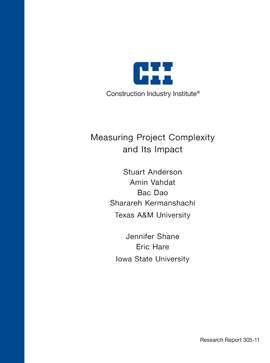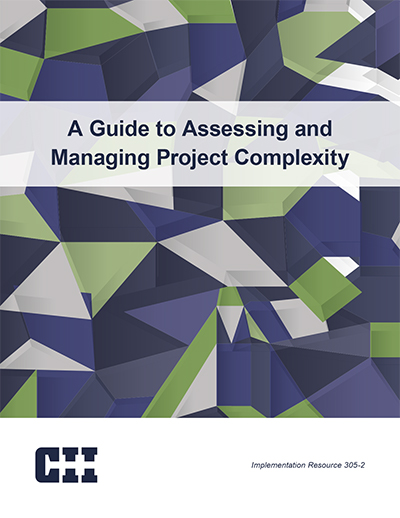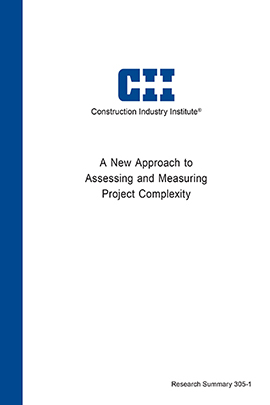
Measuring Project Complexity and Its Impact
Complexity is a catch-all term that is used throughout the construction industry. When complexity is poorly understood and managed project failure and uncertainty become the norm. This research report details how Research Team (RT) 305 worked to define, measure, and suggest management strategies for project complexity. Through a structured research process of working to understand the problem, a literature review, development of a research approach including an extensive survey and subject matter expert workshop, and tool development RT 305 developed the Project Complexity Assessment and Management Process. By completing this process project teams will be able to assess what is contributing to the complexity of the project, measure project complexity, and identify strategies to manage complexity in order to increase the likelihood of success and predictable project outcomes.
The definition of project complexity varies greatly from person to person and project to project. Developing a common understanding of project complexity based on literature about complexity and complexity theory as well as industry experience, RT 305 formed a working definition of complexity.
After developing a definition of complexity the RT 305 developed a three phase research approach to explore the team’s research hypotheses. These hypotheses were to determine what complexity indicators can be used to differentiate between high complexity and low complexity projects and if the identified complexity indicators are directly related to project outcomes. Three phases are 1) exploration of complexity; 2) identify and measure complexity; and 3) complexity relation to practices.
In the first phase of the research process, after developing RT’s definition of complexity, 40 attributes of complexity were identified. Through a lengthy development process RT 305 established for each attribute a definition, set of measures, and possible management strategies.
During the second phase of the project, a survey was developed that explored each of the attributes in greater depth. The survey was deployed to CII membership companies. Responses included a mixture of high a low complexity projects. Based on a statistical analysis of the questions there was a difference in answers between high and low complexity projects for 23 attributes. The questions with observed differences were developed into complexity indicators, thus addressing the first research hypothesis.
An analysis of two sets of data were used to address the second research hypothesis. There is a relationship between the complexity indicators and project performance. The first set of data from the CII Benchmarking and Metrics, which includes one question on project complexity, demonstrated no relationship between complexity and performance. The data analysis on the RT 305 complexity indicators found that there are three indicators with a relationship to cost performance and one indicator with a relationship to schedule performance.
Also during the second phase, RT 305 further advanced the strategies for managing the complexity indicators. This was accomplished through a subject matter expert workshop. The workshop was used to verify the identified complexity indicators and asking the subject matter experts to document possible management strategies for the complexity indicators. A final detailed review of all the strategies was conducted by the research team.
To enable industry use of this knowledge, during the third and final phase of the research, RT 305 developed the Project Complexity Assessment and Management Process, which includes three steps:
Step 1 – Project Complexity Attribute and Indicator Identification
Step 2 – Project Complexity Assessment and Management (PCAM) Tool Application
Step 3 – Project Complexity Strategies to Manage Key Project Complexity Indicators
The Project Complexity Assessment and Management Process is intended to be completed by a project team at least once during project development. However, multiple times may be beneficial to assess changing complexity typical of the nature of a complex project. The outcome of each iteration of the Project Complexity Assessment and Management Process is a team understanding of the complexity of the project, a graphical representation of the level of impact of the complexity indicators, and a list of strategies to help manage the contributing complexity attributes.
Several key findings of this research were:
- Project complexity is very much viewed in terms of industry perspective and experience. Defining, describing, and measuring complexity is in itself complex and therefore less predictable.
- The analysis of survey data identified 37 indicators of complexity (out of 92) that statistically differentiated low complexity projects from high complexity projects. The 37 indicators represent 23 complexity attributes within 11 categories of project complexity.
- Out of the 37 complexity indicators, only three complexity indicators correlated directly to cost performance and one complexity indicator correlated directly to schedule performance. This suggests that the complexity indicators in general do not directly impact project performance. Their impact has a likely indirect influence other project practices and decisions. The effective implementation of these other practices and decisions directly impact successful project performance.
- Strategies to manage complexity were identified for each complexity attribute and its indicator and these vary depending on the nature of the complexity indicator.
- Project complexity can be assessed, evaluated, and managed to reduce the impact of complexity on project practices, project management, and project decision making, thereby increasing the chances of improved capital project performance. In this way, the project complexity assessment and management process, its worksheet and its tool can add value to managing capital projects.



